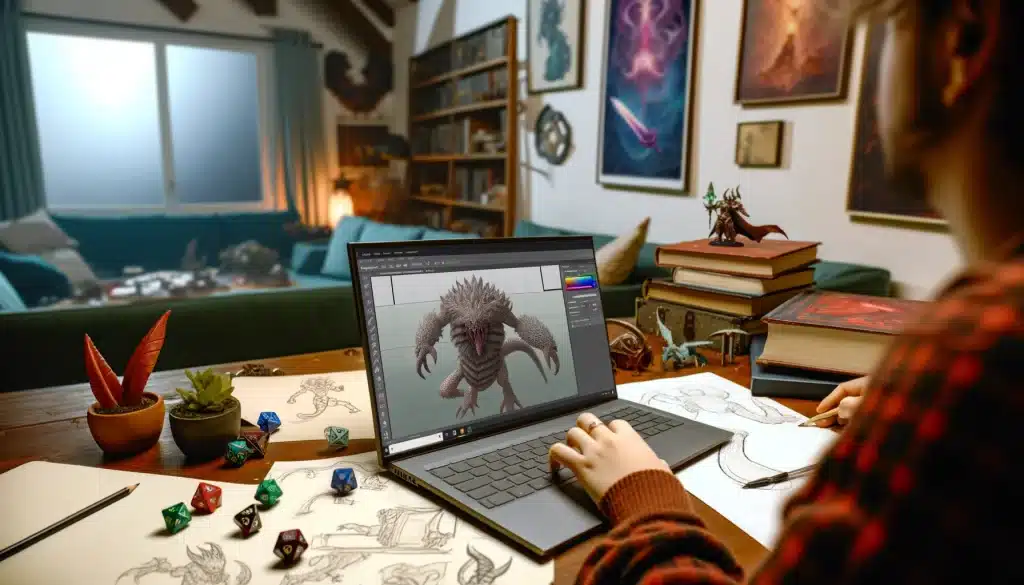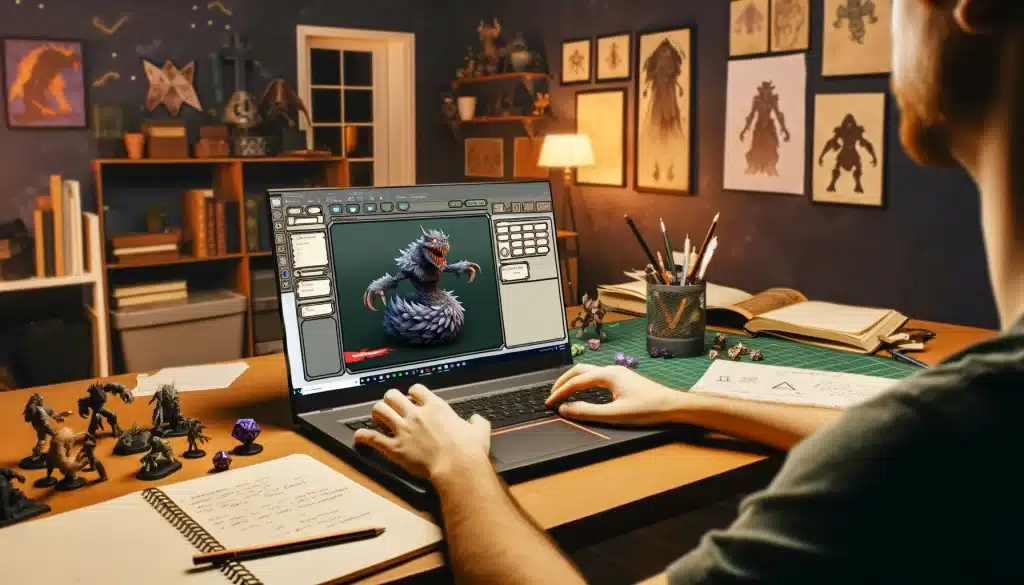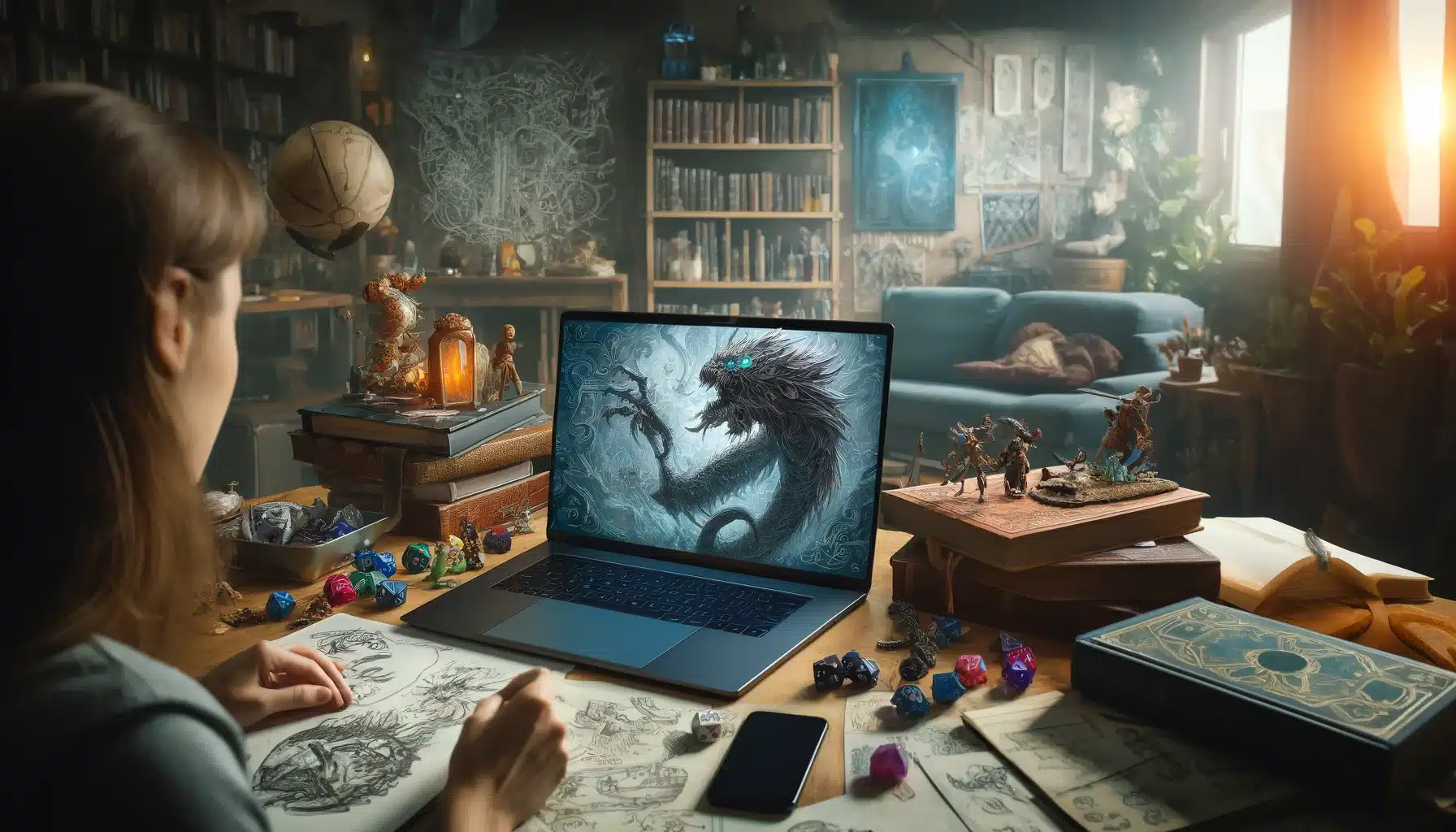Creating unique monsters is a cornerstone of a memorable D&D campaign. While traditional monsters have their charm, introducing fresh, imaginative creatures can truly captivate your players and enhance the storytelling. In this age of advanced AI, tools like ChatGPT can be invaluable for sparking creativity and helping Dungeon Masters craft new and exciting adversaries.
Imagine a creature that defies expectations—a beast that combines elements you wouldn’t normally consider. With ChatGPT, you can brainstorm innovative abilities, traits, and backstories that breathe life into your campaign. Whether it’s a fire-breathing ice dragon or a sentient, shape-shifting forest guardian, the possibilities are endless.
The process begins with a simple concept. By providing ChatGPT with a basic idea, you can receive detailed suggestions that expand on your initial thought. This collaborative brainstorming not only speeds up the creative process but also ensures your monsters are well-rounded and intriguing.
Moreover, ChatGPT can help you flesh out the lore behind your creatures. A monster with a rich backstory adds depth to your world, making encounters more than just battles—they become stories within the larger narrative of your campaign. Embrace the power of AI to enhance your creativity and keep your players eagerly anticipating what comes next.
Starting with a Concept
Creating a unique monster starts with a compelling concept. Begin by thinking about the role you want this creature to play in your campaign. Is it a powerful boss meant to challenge your players in combat, or a mysterious entity that adds depth to the lore of your world? Establishing the creature’s purpose helps shape its abilities, appearance, and backstory.
Define the Theme
Decide on the thematic elements that will define your monster. Themes can include:
- Elemental: Creatures that embody natural elements like fire, ice, or earth.
- Mythical: Beings inspired by mythology, such as a chimera or a dragon.
- Horror: Monsters designed to instill fear, like undead horrors or eldritch abominations.
- Fantasy: Creatures with magical abilities and fantastical origins.
For example, you might want to create a creature that embodies both fire and ice, combining the destructive power of flames with the freezing touch of ice. This duality can lead to interesting abilities and a visually striking appearance.
Establish Unique Abilities
Once you have a theme, think about the unique abilities that set your monster apart. Ask ChatGPT for ideas on special attacks, defenses, and magical powers. Consider how these abilities can create challenging and memorable encounters for your players. For instance, a fire-ice creature might have attacks that can both burn and freeze, or it could switch between fire and ice forms, each with different strengths and weaknesses.
Try my AI Tabletop RPG generators...and an extensive library of content!
Create a Backstory
Every great monster has a backstory that explains its origins and motivations. Use ChatGPT to flesh out the history of your creature. Was it created by a powerful wizard, born from a natural disaster, or a remnant of an ancient civilization? A rich backstory can provide plot hooks and deepen the lore of your campaign. For example, your fire-ice monster might be the guardian of a long-lost temple, with a legend that ties into the main quest.
Design the Appearance
Visualize your monster’s appearance with vivid details. Describe its size, shape, color, and any distinctive features. ChatGPT can help generate creative descriptions that make your creature stand out. For instance, your fire-ice monster might have a body covered in molten lava that periodically freezes into icy spikes, creating a constantly shifting form that is both beautiful and terrifying.
Integrate into the Campaign
Finally, think about how to integrate your monster into the campaign. Consider its habitat, its behavior, and how it interacts with other creatures in the world. Plan how and when your players will encounter it. Will it be a random encounter in a dangerous area, or a climactic battle in a story arc? Using ChatGPT, you can brainstorm scenarios that make the encounter memorable and meaningful.
⚔️ Fantasy RPG Random Tables Books
Make life as a Gamemaster easier…
If you play Dungeons & Dragons, Pathfinder, or other fantasy RPGs, this
RPG random tables series
is packed with encounters, NPCs, treasure, and more. Available in eBook or print—either way, you’ll have a wealth of adventure ideas at your fingertips.
By starting with a strong concept and developing it through these steps, you can create a monster that not only challenges your players but also enriches the storytelling of your campaign. Use ChatGPT to enhance your creativity, ensuring each monster is a unique and integral part of your D&D world.

Detailing Abilities and Traits
Once you have a solid concept for your monster, it’s time to dive into its abilities and traits. This step is crucial for making your creature not only unique but also challenging and engaging for your players.
Offensive Abilities
Start by defining the offensive capabilities of your monster. Think about:
- Primary Attacks: What are its main methods of dealing damage? For example, a fire-ice creature might have a breath attack that alternates between scorching flames and freezing ice shards.
- Special Moves: Unique attacks that add an element of surprise. Perhaps it can create firestorms or ice walls, altering the battlefield dynamically.
Ask ChatGPT to generate ideas for these abilities. You might receive suggestions like:
- Elemental Burst: A powerful attack that deals both fire and ice damage.
- Frostfire Aura: An area-of-effect ability that burns and slows enemies within a certain radius.
Defensive Traits
Next, focus on the creature’s defenses. Consider what makes it tough to defeat:
- Resistances and Immunities: Is it resistant or immune to certain types of damage? A fire-ice creature might be immune to both fire and ice damage but vulnerable to water or earth attacks.
- Regeneration: Does it have the ability to heal itself? This could be a passive trait or an activated ability, like regenerating health when switching between fire and ice forms.
ChatGPT can suggest defensive traits like:
- Molten Armor: Hardens into a protective shell when attacked, reducing damage taken.
- Frozen Core: Regenerates health rapidly when in a colder environment.
Special Abilities
Unique abilities can set your monster apart. Think about powers that add depth and complexity to encounters:
- Shape-Shifting: Can it change its form to adapt to different combat situations? A fire-ice creature might switch between fiery and icy forms, each with different abilities and stats.
- Environmental Manipulation: Can it control the battlefield in some way? Perhaps it can create hazardous zones or summon elemental minions to aid in battle.
Ask ChatGPT for imaginative special abilities:
- Elemental Fusion: Temporarily merges fire and ice powers for a devastating combo attack.
- Thermal Shock: Causes extreme temperature changes that disorient and damage foes.
Behavioral Traits
Consider how the monster behaves in and out of combat:
- Aggression: Is it highly aggressive, or does it prefer to ambush and strike from the shadows?
- Tactics: Does it have a particular strategy, such as targeting the weakest party member or focusing on spellcasters first?
Behavioral traits can make encounters more interesting. ChatGPT might suggest:
- Territorial Defender: Fiercely protects its lair, using the environment to its advantage.
- Cunning Predator: Uses hit-and-run tactics, retreating to regenerate before striking again.
Weaknesses and Vulnerabilities
Lastly, balance your monster by giving it some weaknesses. Every powerful creature should have a few Achilles’ heels:
- Elemental Weakness: If it’s resistant to fire and ice, perhaps it’s vulnerable to lightning or earth magic.
- Behavioral Flaws: Maybe it becomes enraged and less tactical when wounded, making it easier to predict and counter its moves.
Ask ChatGPT for suggestions on weaknesses to balance your creature:
- Brittle Underbelly: A specific weak spot that takes extra damage when hit.
- Elemental Instability: Overuse of its abilities can cause it to become unstable, dealing damage to itself.
By detailing your monster’s abilities and traits, you can create a formidable and memorable adversary that will challenge your players and enrich your campaign. Use ChatGPT to brainstorm and refine these ideas, ensuring each ability and trait contributes to a cohesive and engaging monster design.
Crafting a Backstory
A compelling backstory breathes life into your monster, transforming it from a mere obstacle into a key part of your campaign’s lore. Start by considering the origins of your creature. Where did it come from? How was it created? Use LitRPG Adventures RPG tools with AI to generate detailed backstories that integrate seamlessly with your world.
Origin Story
Think about how your monster came into existence. Was it the result of a magical experiment gone wrong? Perhaps it was summoned from another dimension or evolved in a secluded environment. Ask ChatGPT to help flesh out these details, creating a rich history that adds depth to your creature. For instance, a fire-ice creature might be the offspring of a fire elemental and an ice giant, born from a forbidden union.
Historical Impact
Consider the historical significance of your monster. Has it played a role in major events in your world? Maybe it was involved in an ancient war or served as a guardian for a long-lost civilization. ChatGPT can help you weave these historical threads into your campaign, creating connections that enrich the overall narrative.
Motivations and Goals
Define the monster’s motivations and goals. What drives it? Is it seeking revenge, protecting its territory, or following the commands of a powerful master? Understanding its motivations can help you design encounters that feel meaningful and engaging. For example, your fire-ice creature might be driven by a desire to reclaim its ancestral homeland, now occupied by adventurers.
⚔️ Fantasy RPG Random Tables Books
Make life as a Gamemaster easier…
If you play Dungeons & Dragons, Pathfinder, or other fantasy RPGs, this
RPG random tables series
is packed with encounters, NPCs, treasure, and more. Available in eBook or print—either way, you’ll have a wealth of adventure ideas at your fingertips.
Relationships and Conflicts
Think about the relationships your monster has with other creatures and factions in your world. Does it have allies or enemies? Are there rival monsters or organizations that oppose it? Use ChatGPT to brainstorm these relationships, adding layers of intrigue and conflict to your campaign. Your fire-ice creature might be at odds with a rival elemental lord or have a pact with a secretive mage guild.
Legends and Myths
Integrate your monster into the folklore of your world. What do the locals say about it? Are there ancient prophecies or myths surrounding its existence? Using ChatGPT, you can generate legends and myths that add a sense of mystery and awe to your creature. Perhaps there is a legend that the fire-ice creature will bring about a new age of balance between fire and ice.
By crafting a detailed backstory with the help of ChatGPT and LitRPG Adventures RPG tools, you create a monster that is not just a foe, but a vital part of your campaign’s tapestry. This depth will make encounters more immersive and memorable for your players, as they uncover the history and motivations behind the creatures they face.

Visualizing the Monster
Creating a vivid and memorable visual for your monster is essential for making it come to life in your campaign. Here are some tips for using DALL·E to generate images that capture the essence of your unique creature.
Define Key Features
Start by identifying the most distinctive features of your monster. Consider its size, shape, color, and any unique characteristics. For instance, if you’re creating a fire-ice creature, think about how fire and ice elements can be integrated into its design—like a body with both molten lava and icy spikes.
Use Detailed Descriptions
When using DALL·E, provide a detailed description to ensure the AI captures your vision accurately. Include specifics like:
- Appearance: Describe the overall look, such as “a towering beast with fiery mane and frozen claws.”
- Textures: Mention textures like “molten lava skin” or “frost-covered scales.”
- Environment: Place the creature in its natural habitat, like “a fiery and icy cave.”
Combine Elements
Mix and match different elements to create a truly unique monster. For example:
- Body Composition: “The creature’s body is a blend of flowing lava and solid ice.”
- Special Features: “Its eyes glow with a fiery red light, and its breath emits a chilling frost.”
Experiment and Refine
Don’t be afraid to experiment with multiple prompts to get the perfect image. Refine your descriptions based on the outputs you receive, adjusting details to better match your vision.
Example Prompt
“Create a large, intimidating monster with a body that combines fire and ice. Its skin appears to be made of molten lava, with patches of ice forming spikes along its back. The creature has glowing red eyes and breathes a chilling frost. It stands in a cave where fire and ice elements are both present.”
Using these tips, you can leverage DALL·E to generate stunning and unique visuals that bring your monster to life, making it an unforgettable part of your D&D campaign.
Fine-Tuning with Feedback
Once you’ve introduced your unique monster into your campaign, gather feedback from your players. Pay attention to their reactions during encounters. Did they find the monster challenging and engaging? Were they surprised by its abilities and appearance? Use these insights to refine your creation.
Ask your players for their thoughts after the session. Encourage honest feedback about what worked well and what could be improved. This dialogue helps you understand their perspective and identify areas for enhancement.
Consider adjusting the monster’s abilities, appearance, or backstory based on the feedback. Maybe its attacks were too powerful or not diverse enough, or perhaps the lore didn’t resonate as intended. Making these tweaks ensures the monster remains a dynamic and balanced part of your campaign.
Reintroduce the refined monster in future encounters. This iterative process allows you to continuously improve and adapt your creations, making each encounter more exciting and memorable for your players.
Conclusion
Creating unique monsters for your D&D campaign with the help of ChatGPT and tools like LitRPG Adventures RPG tools can significantly enhance your storytelling. By starting with a solid concept, detailing abilities and traits, crafting a rich backstory, visualizing the monster, and fine-tuning with feedback, you can develop creatures that challenge and captivate your players. Embrace the power of AI to spark your creativity and elevate your campaign to new heights. With these tools and techniques, you’ll create unforgettable adventures that keep your players eagerly coming back for more.









